Mechanisms of SARS-CoV-2 neutralization by shark variable new antigen receptors
Mechanisms of SARS-CoV-2 neutralization by shark variable new antigen receptors elucidated through X-ray crystallography Obinna C. Ubah, Eric W. Lake, Gihan S. Gunaratne, Joseph P. Gallant, Marie Fernie, Austin J. Robertson, Jonathan S. Marchant, Tyler D. Bold, Ryan A. Langlois, William E. Matchett, Joshua M. Thiede, Ke Shi, Lulu Yin, Nicholas H. Moeller, Surajit Banerjee,
Growth estimates of young-of-the-year broadnose sevengill shark
Growth estimates of young-of-the-year broadnose sevengill shark, Notorynchus cepedianus, a top predator with poorly calcified vertebrae Andrés J. Jaureguizar, Federico Cortés, J. Matias Braccini, Rodrigo Wiff, Andrés C. Milessi ABSTRACT: The broadnose sevengill shark, Notorynchus cepedianus (Péron, 1807), is a large marine top predator in temperate coastal ecosystems. Some aspects of its life history have
Leopard Seals Predating on Chondrichthyans
Leopard Seals (Hydrurga leptonyx) in New Zealand Waters Predating on Chondrichthyans Krista van der Linde, Ingrid N. Visser, Rick Bout, Chris Lalas, Lara Shepherd, David Hocking, Brittany Finucci, Jim Fyfe, Matthew Pinkerton ABSTRACT: Leopard seals (Hydrurga leptonyx) are top-order predators that prey on a wide variety of species including crustaceans, cephalopods, fishes, birds, and pinnipeds.
Hawaii: Shark fishing ban goes into effect January 1
Press Release Division of Aquatic Resources, Hawaii — —- —- —- — —- — A bill passed by the 2021 State Legislature banning shark fishing will take effect January 1, 2022. Act 51 (House Bill 553) makes it illegal to knowingly capture, entangle, or kill a shark in state marine waters. The new law applies
The Effects of Climatic Variability on the Feeding Ecology of the Scalloped Hammerhead Shark
The Effects of Climatic Variability on the Feeding Ecology of the Scalloped Hammerhead Shark (Sphyrna lewini) in the Tropical Eastern Pacific Camila Arnés-Urgellés, Pelayo Salinas-de-León, Etienne Rastoin-Laplane, Leandro Vaca-Pita, Jenifer Suárez-Moncada, Diego Páez-Rosas ABSTRACT: Climatic variability changes ocean productivity and generates systematic cascading effects in marine food webs. Studying the feeding ecology of top predators,
Intensive Commercialization of Endangered Sharks and Rays Along the Coastal Amazon
Intensive Commercialization of Endangered Sharks and Rays (Elasmobranchii) Along the Coastal Amazon as Revealed by DNA Barcode Thais Martins, Paula Santana, Ítalo Lutz, Raimundo da Silva, Aurycéia Guimarães-Costa, Marcelo Vallinoto, Iracilda Sampaio, Grazielle Evangelista-Gomes ABSTRACT: Elasmobranchs represent a well-defined group, composed of about 1,150 species inhabiting diverse aquatic environments. Currently, several of these species have
Reproductive biology aspects of Alopias pelagicus and A. superciliosus
Reproductive biology aspects of Alopias pelagicus and A. superciliosus (Lamniformes: Alopiidae) in the Ecuadorian Pacific Briones-Mendoza J, Carrasco-Puig P, Toala-Franco D. ABSTRACT: The reproductive biology of thresher shark species of the Ecuadorian Pacific was analysed based on 1236 specimens of Alopias pelagicus (711 females and 525 males) and 354 of A. superciliosus (164 females and
Shark and ray research in India has low relevance to their conservation
Shark and ray research in India has low relevance to their conservation Trisha Gupta, Divya Karnad, Shruthi Kottillil, Sudha Kottillil, E.J. Milner Gulland ABSTRACT: With global biodiversity currently facing unprecedented losses, it is critical that resources are allocated and used effectively to mitigate these threats, especially in resource-limited tropical countries of the global south. Chondrichthyans
Regional variation in anthropogenic threats to Indian Ocean whale sharks
Regional variation in anthropogenic threats to Indian Ocean whale sharks Samantha D. Reynolds, Bradley M. Norman, Craig E. Franklin, Steffen S. Bach, Francesco G. Comezzi, Stella Diamant, Mohammed Y.Jaidah, Simon J. Pierce, Anthony J. Richardson, David P. Robinson, Christoph A. Rohner, Ross G. Dwyer ABSTRACT: Conservation and management of mobile marine species requires an understanding
Sharks, rays and chimaeras of the Seine and Unicorn seamounts
Sharks, rays and chimaeras of the Seine and Unicorn seamounts (NE Atlantic Ocean) Mafalda FREITAS, Ricardo SOUSA, Pedro IDEIA, Madalena GASPAR, João DELGADO, Ana Luísa COSTA, Antonina dos SANTOS & Manuel BISCOITO ABSTRACT: Background Seamounts are underwater mountains which typically rise rather steeply at least several hundred meters above the deep-sea floor. These geological features
Performance of iSharkFin in the identification of wet dorsal fins from priority shark species
Performance of iSharkFin in the identification of wet dorsal fins from priority shark species Monica Barone, Frederik H. Mollen, Jenny L. Giles, Lindsay J. Marshall, Melanie Villate-Moreno, Carlotta Mazzoldi, Elisa Pérez-Costas, Jürgen Heine, Cástor Guisande González, ABSTRACT: The past decade has seen a considerable rise in international concern regarding the conservation status of sharks and
Generation of VNAR Libraries from Immunized Sharks
Generation of VNAR Libraries from Immunized Sharks and Selection of Target-Specific Clones Helen Dooley ABSTRACT: Cartilaginous fishes (sharks, skates, rays, and chimeras) are the most phylogenetically distant lineage relative to mammals in which somatically rearranging immunoglobulins (Igs or antibodies) have also been found. Alongside their conventional (heavy-light chain) isotypes, IgM and IgW, sharks produce the novel
A review of America’s batomorph anomalies
Morphological abnormalities in seven American round ray specimens: A review of America’s batomorph anomalies Nicolás Roberto Ehemann, Francisco Javier García-Rodríguez, José De La Cruz-Agüero ABSTRACT: Although morphological abnormalities in several rays and skate species around the American continents have frequently mentioned, their numbers are unknown. The present work record morphological abnormalities in four Urotrygonidae species.
Sideway swimming behaviour by aggregating blacktip sharks in mid-water column
Sideway swimming behaviour by aggregating blacktip sharks (Carcharhinus limbatus) in mid-water column Weideli, O., Medd, H. ABSTRACT: N/A Mar. Biodivers. 51, 92 (2021). DOI: 10.1007/s12526-021-01242-4 SOURCE
Towards a new understanding of elasmobranch hearing
Towards a new understanding of elasmobranch hearing Megan F. Mickle, Dennis M. Higgs ABSTRACT: Elasmobranchs are of important global conservation concern, however their hearing abilities, use of sound, and responses to anthropogenic noise pollution are all vastly understudied, despite noise pollution being an ever-increasing concern to global fish populations. This review focuses on the hearing




